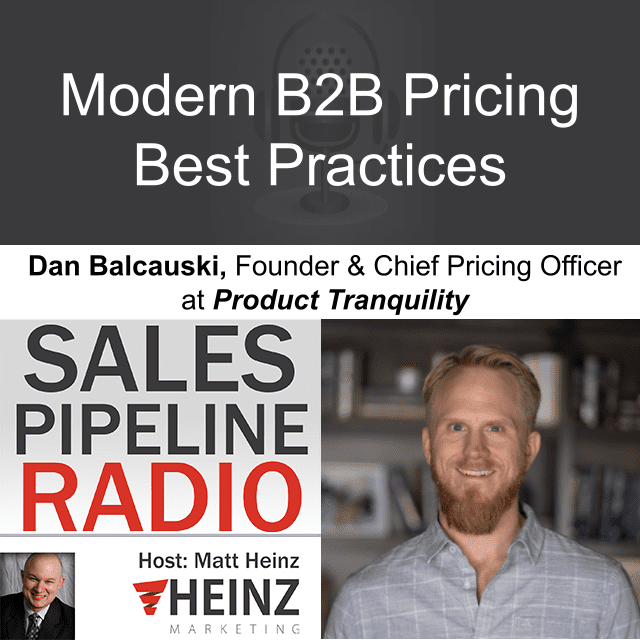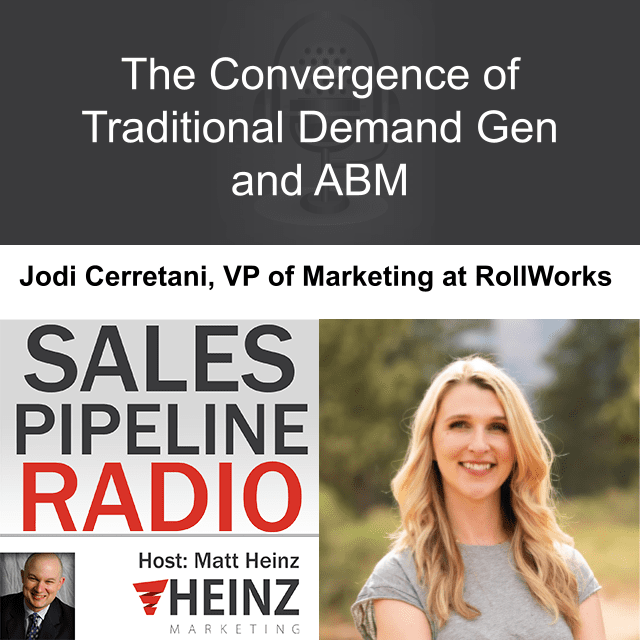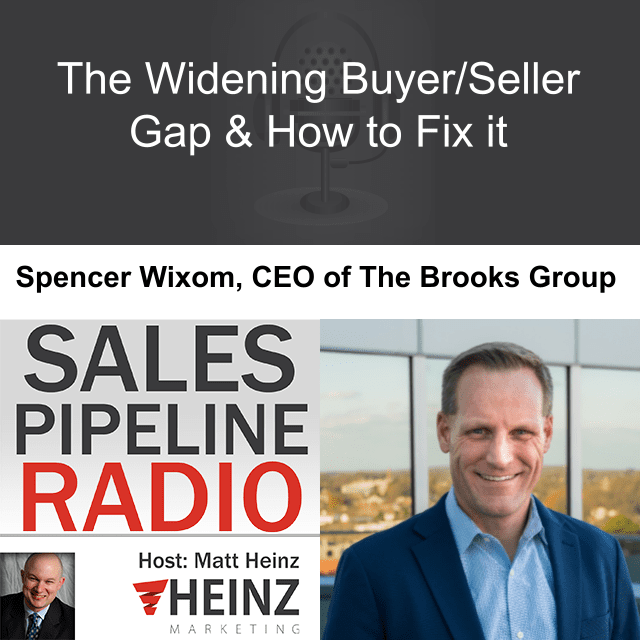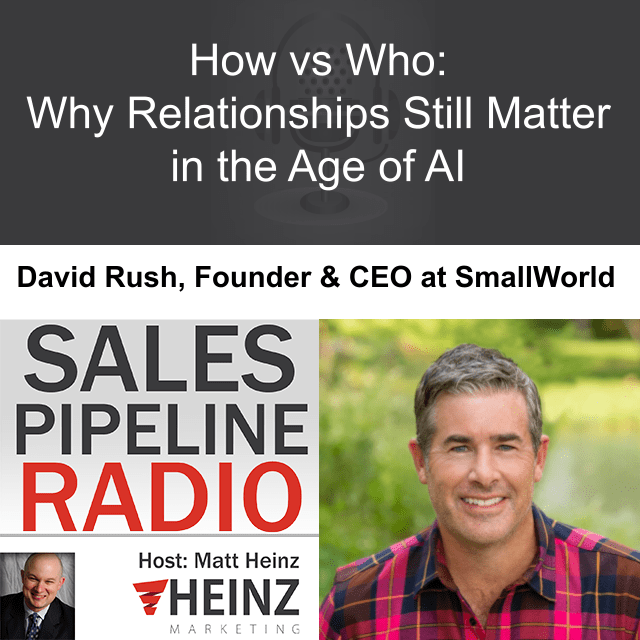Sales Pipeline Radio, Episode 341: Q & A with Dan Balcauski

By Matt Heinz, President of Heinz Marketing
If you’re not already subscribed to Sales Pipeline Radio or listening live every Thursday at 11:30 am Pacific on LinkedIn (also on demand) you can find the transcription and recording here on the blog every Monday morning. The show is less than 30 minutes, fast-paced and full of actionable advice, best practices and more for B2B sales and marketing professionals.
We cover a wide range of topics, with a focus on sales development and inside sales priorities. You can subscribe right at Sales Pipeline Radio and/or listen to full recordings of past shows everywhere you listen to podcasts! Spotify, iTunes, Blubrry, Google Play, iHeartRADIO, Stitcher and now on Amazon music. You can even ask Siri, Alexa and Google or search on Audible!
This week’s show is entitled, “Modern B2B Pricing Best Practices“. My guest is Dan Balcauski, Founder and Chief Pricing Officer at Product Tranquility.
Tune in to:
- Explore why pricing is often overlooked and underestimated in B2B marketing, and how it can be a crucial factor in business success.
- Rethinking Freemium: Understand the limitations of freemium pricing in B2B SaaS and why a free trial approach is often more effective. Discover why freemium can attract the wrong customer segments and distract from building a product that real target customers are willing to pay for.
- Unveiling the Concept of Pricing Fairness: Delve into the notion of fairness in pricing and its influence on customer perception. Explore the importance of considering personal and social fairness, along with the role of voice and choice in ensuring customer acceptance of pricing changes.
Watch the video, listen in below and/or read the transcript below.
Matt: Welcome everyone to another episode of Sales Pipeline Radio. My name is Matt Heinz. I am your host. We are here live Thursdays at 11:30 Pacific 2:30 Eastern. Thank you so much for joining us today. We’ve been dark the last couple of weeks as I joined my family down in our annual trip to San Diego, but back and back in the saddle and excited to be here.
If you are catching us live in the middle of your workday, thank you so much for making us part of your day. If you’re watching or listening on demand, very much appreciate you being part of this, every episode of Sales Pipeline Radio past, present, and future always available at salespipelineradio.com. I’m very excited to have with us today, live from sweltering Austin, Texas, the founder of Product Tranquility, Dan Balcauski. Dan, thanks for joining us.
Dan: Great to be here, Matt. I’m excited for our conversation and thank you to anyone who’s joining us live in the middle of the workday. I appreciate it.
Matt: Absolutely. Well, look, I don’t have an MBA. I didn’t go to business school. I didn’t really study business, but I, I’m familiar with these four P’s that we talk about in marketing forever. And I feel like in B2B, we have become fixated with promotion as really the primary B2B marketing function. Your business really focuses primarily on pricing. And I feel like it is a lost art oftentimes amongst marketers and something that we don’t really take seriously and don’t think strategically enough about. So start by introducing people to you, your background, and then we’ll get into it.
Dan: Absolutely. Well, I completely agree. I think it is a, well, maybe not lost art. I think it’s a building art, you know, in much of the way that product management has built into itself into an actual legitimate practice over time.
I think pricing is on that same journey. And I see the building blocks every day, getting us closer and closer to that. But, you know, I spent my entire 20-year career in software. I started more on the, we’ll call the value creation side and value capture side at first as an engineer and engineering management.
Ultimately, I became much more fascinated by how our products created customer value and turned into dollars and cents for the business than the individual bits I was moving around in the software. And this interest led me to pursue my MBA. I didn’t realize it then, but I was quite lucky with pursuing my MBA.
Kellogg was a widely recognized for its excellence in marketing. I didn’t find out until very recently, very few MBA programs have courses in pricing, so I got my theoretical grounding and pricing there and got thrown into the pricing world, immediately in my internship where company very successful Silicon Valley startup I was working for, they had a question on CEO’s desk of should they do a freemium approach and asked me to help them figure it out at TLDR. We might get into it later, but definitely do not recommend freemium for any of our listeners. So we’ll put a pin in that. Maybe we’ll come back to it later, but you know, over time spent more time on the value creation side and product management.
And you’re right. Like there were product marketing at those companies was ostensibly responsible for pricing, but they would come to me and be like, well, I’ve got to do this pricing thing. I don’t know what they’re supposed to do. Like you may, you’ve got some background in this, right? Could you help?
Between the theoretical grounding and business school by MBA internship. And then the other product marketers being asked to do this analysis. I don’t really know what they should be doing here. Got my feet wet on, on that side of the thing. So now I that’s all I do is help founders and CEOs define pricing packaging for new and existing businesses, helping them make sustainable pricing practices that help them be profitable and serve as many customers as possible.
So immediately a LinkedIn profile, best practice. If you look them up on LinkedIn just “Balcauski”, just his last name, you’re going to see his headline under his name says “I dispel B2B SaaS pricing illusions”, which begs the question: What are some illusions of B2B SaaS pricing? I mean, we can talk about best practices. Let’s talk about dumpster fires first. What are some of the things that people get wrong, in a well-meaning way or otherwise?
Dan: I think the first one is when it comes to SaaS pricing, most executives think that what you charge determines your success.
In fact, who and how you charge determines your success. So often these conversations with people here who do pricing, they want to talk about, “okay, should our price be $19 user or $99 user?” Should it end in fives and nines? That’s all very interesting, but if I were you, I’d spend most of my time on what the price tag goes on and who I’m selling it to and much less time on what number actually goes on the particular price tag? So that’d be one. I could list off some more if you want.
Matt: Let’s go, let’s get at least one more. Absolutely. Yeah.
Dan: So I think the other thing is you don’t really have a choice of whether you will have a pricing conversation with your customer.
The only decision you get to make is when you will have that conversation and let’s, for the love of God, hope it’s not your poor sales rep when you just launched the product and he’s having initial conversations trying to sell the product you just invested millions, if not tens of millions of dollars into , that’s the first pricing conversation you’re having.
So, I highly recommend as much as you could front load the pricing conversation. Yeah, I would put the cart all the way behind the horse and let’s start with pricing as a way to help determine what we should build in the first place. Let’s not wait until we’ve somehow– at some point, Pricing and packaging got slotted into the marketing launch plan sequence of like, okay, well, we’re 30 days out from launch.
So now we’ve got to figure out what our pricing and packaging looks like. Absolutely not. It should have been there from day one, because eventually you’re going to have to have these conversations with your customers. So why not get it out of the way upfront, really understand what your market is willing to pay for before you invest millions, if not tens of millions of dollars.
Matt: Well, in pricing has to have context, right? Like whether I charge $10,000 or 10 million dollars, those are very big differences in numbers, but like the context of like, what am I getting? What’s the value? What does that mean? Help me understand how to think about the number, but then the key pillars of the context behind justifying the right number.
Dan: Yeah, so I think there’s a couple of different dimensions there. The first is that intelligent price management follows from intelligent value management. I have an overall model I use for SAS pricing. It’s called The Services Model stands for the four components of the model: segments, value, competition, and strategy.
We’ll touch on those first two elements. Cause I think they’re incredibly relevant to what you’re talking about. So the first is that we really, in any pricing exercise, and you’ve got an audience of marketers, so I’m sure they’ll appreciate this. We really need to start with customer segment.
Customer segment is critical. Because customers in different contexts will value your product differently. They will also have different competitive alternatives available to them. They will rank order, different value drivers of your product. So understand they will have different constraints that dictate what is, and what is it was not feasible.
What’s causing them friction in their current environment? So we have this all the time, right? If, I, am on a drive across country, I stop at a gas station, I buy a bottle of water, that bottle of water is going to have a distinctly different value to me than if I’ve been walking through the Sahara desert for the last two weeks and someone tries to sell me a bottle of water, that water will have a distinctly different value and price I’m willing to pay depending upon that context.
Matt: You brought up earlier this idea of presenting price and doing it earlier. And I think if you talk to a lot of salespeople, that is a very stressful conversation. I think there’s a lot of fear about bringing up pricing in a sales conversation. You’re throwing out a ton of the just truth bombs around thinking about the value side before the pricing side.
And honestly, in the sales process, if you can identify the value, if you can identify quantity and quality, identify the value, the impact that’s going to have and the importance that has to your prospect, it puts the value in and in context and puts the pricing context. Why do you think so many salespeople have a fear of bringing up pricing? And how do you help mitigate that?
Dan: Because they’re operating without any sort of guidance from on high, right? So, when I was talking about having pricing as early as possible. I was not even talking about the sales competition. I was saying, move that up. The product management team, the product marketing team, the executive team that is thinking about developing a net new product needs to be thinking about their pricing and packaging from day one.
And we should not be leaving it to the end salesperson. Now as we get into nuance here, right? There is a difference between what you might call product versus services pricing and services pricing. Every offer, if you’re doing consulting is customized. Right. And you, have a value discovery conversation at an individual level with a, with a customer, right?
Because you’re, you’re building a customized offering for them. Going back to your point though, these salespeople, they’re not having a good pricing time with pricing because they don’t have strong pillars to stand on. Right? We can’t just do value-based pricing. The pricing team or whoever goes off into a closet somewhere and does some ROI calculations and then springs it on the rest of the org and says, “all right, here you go, sales team, go sell a thing at this price” because they’re going to be ill equipped, right? Because you have to have value-based selling, value-based customer success, value-based messaging, right? So, unless it’s a true organizational mandate held on high that, we’re going to support everything we do with a value based mindset, like they’re going to have sales teams out there on their own. Right. And then what, what tool do they have? If they haven’t been given the support that they need, the enablement, the training the foundational pillars of a strategic, a price list, a good, overall discounting, strategy that’s, that’s actually enforced. What tools left to them? Is it leave price to the last minute and then discount if pressed. So, so I don’t blame them.
Matt: Talking today on Sales Pipeline Radio with Dan Balcauski. He’s the founder of Product Tranquility. If you haven’t already, check out producttranquility.com. Don’t miss it. Lots of great content. We’re going to have to bring you back, talk about value pricing steps to calculating a SaaS economic value.
There’s so many great topics we can cover here, but you mentioned something earlier. I thought I heard you say this. Is that you are anti freemium, is that right?
Dan: I am. That is correct.
Matt: All right. So freemium is a very popular strategy or tactic in a lot of SaaS companies. A lot of product led growth folks like live on it. I’ve heard pros and cons on both sides of this. I’d love to hear your take. Why are you anti freemium?
Dan: Yeah, so first of all, keep in mind, I deal with only B2B SaaS at this point. So one misconception or mis construal around pricing is people try to adopt things that may work in a B2C context into a B2B context and they fail dramatically, right? So, this not only applies to freemium, but people think about AB testing pricing. And that’s an absolute nightmare. Never do that in B2B. You’re going to have a bad time. I promise you, but you asked about freemium specifically. So, I think that’s probably the first misconception is people are like, Oh, I saw, you know, this consumer company do it.
I saw this candy crush app that I have on my phone. They do freemium. So, I’m going to use it for my enterprise workflow software. No, absolutely not. The better answer, number one, anyone says freemium almost universally, the better answer is free trial. I’m absolutely a huge fan of free trial.
And, and I think free trials make a lot of sense. Free trials and freemium generally work under the idea that of what economists call software, they would classify it as an experience good. So, there’s search goods, experience goods, and credence goods. Search good, it would be like you’re buying a can of Campbell’s tomato soup so I could search for it online and know what I’m going to get, right? If I’ve had that before versus experience good, right? You might think like getting a haircut, right? Like I don’t know until I’m done with that. I can’t really judge the value of it. With software our experience and our perceived value changes as we use the software and so a free trial really helps that I know you’ve got a lot of really smart talented marketing folks that listen to this show. Those folks can do all of the web design, copywriting, messaging, work white papers, webinars.
But until there’s something primal, this hits our lizard brain. When we see our own data in a piece of software that really changed our perceived value of it and a free trial accomplishes that. But a freemium, uh, it, it just doesn’t work for a whole lot of reasons. I know we’re running out of time, so I’m happy to elaborate them.
Number one is, I think it creates is a giant mirage. So first of all, what I see happen is that the people that end up on the free side are fundamentally different than you’re paying users. I’ve seen this in extremists with some clients where if you go on like Trust Radius or G2 or any of those review sites, you’ll actually see a bunch of reviews that don’t make any sense.
It’s because the people that for B2B SaaS company is because the reviews that they see on those sites are from are from consumers. They’re from like families who are using it for some home use case. But you know, they outnumber the business use case 10 to one. Those people are never going to buy in the model that you want and they’re polluting your go to market messaging.
So, and then also you’re filtering all of that user data into the product management organization. Sometimes they’re getting feedback from multiple different channels. They, they’re not always checking who’s a free user, who’s a paid customer when they’re getting feedback and soliciting it and all of a sudden, you’ve got a whole user segment that’s not your real target market. And also, I think it’s, it’s this barrage, right? Again, very talented marketers I’m sure who work every day to get customers and there’s this tension of, OK 99% of our user base is on the free side. It’s really hard to do SEO, to do paid search, to do social, to get new customers. If we just tried a little bit harder with our product, if we just did XYZ, change this onboarding flow, added this feature that the free users say they want… it’s like, I’ll sell one toothbrush to every man in China kind of thing.
If I could only convert 1% or 2% of those free users, but it’s a mirage. And I think it just ends up wasting a bunch of time, energy, and resources in the organization that is better spent just building a product that real users who are your target customers will pay for.
Matt: Fantastic soapbox on freemium. I love it. So many people just put in comments and I want to go back to something Jill said earlier I think reinforces your point here, Dan, that, pricing is part of the launch discussion when done well — it’s too often part of the last discussions versus sort of earlier in the conversation.
And just because you discuss value and price up front doesn’t mean you might change and pivot, but to make that a core component of the discussion versus an afterthought, I think is important here. In the last few minutes, we have here, Dan Balcauski thanks for joining us today on Sales Pipeline Radio. He’s the founder of Product Tranquility.
You brought up right before we went on the air, this concept of pricing fairness and fairness– we can spend a whole other hour just talking about just what fairness means relative to price, but maybe unpack like why this has become kind of controversial of late. And what are your thoughts on it?
Dan: We talk a lot about price differentiation. And so, people are like, “well, no, everyone should pay a fair, same price”. The thing is, is that your definition of fairness really is a lot more influenced by tradition than you realize.
So, one example would be, I pay one price when I get on a bus, but a senior citizen pays another price. And maybe in the US that made sense at one point. But if you look at the demographic information now, pretty much 98% of the wealth is owned by people over 50 years old. So why are they going to get discount to ride the bus when our poor millennial friends are not necessarily doing that, right?
The thing is, is because that’s been a tradition. It’s we’ve always had senior citizen discounts. And so, we continue to. If I go to Europe, I, they put bread on the table and I eat it, I’m going to get charged for that bread. But in the US, they put bread on the table, and I eat it. I’m not because we have tradition that the bread is free.
So, if I get charged in Europe, American visiting over there for summer, I’m going to be upset. “This is unfair. I didn’t order the bread. You put it on the table.” “Yes, but you ate it “and that’s social tradition. So, I think one of the things that’s really come up over the last couple of weeks, and we don’t have time to unroll the whole scenario, but anyone who’s been following the saga with Reddit has noticed a major fairness problem with the reaction they have. They rolled out pricing changes for their Reddit’s API and end up having a revolt on their hands from all of the moderators who are free users of Reddit that take their free time to help Reddit moderate their discussion forums and basically ended up having a full-blown revolt on their hands.
So, one of the things we go through in terms of fairness is first we judge the outcome. All right, here’s this price. Is this, do I judge this as personally fair? If the answer is no, then I go to this other section of social fairness, right? So is there a precedent for it? And what was the process?
So, I think this is really where Reddit fell down is one of the aspects we look for when we’re judging social fairness is voice and a choice. If you give your customers a ability to give a, give their voice, give their opinion about an upcoming change, then they’re much more likely to accept it.
Even if the end result ends up not being perceived as fair so we go through this this two-step process of is it personally fair to me? Okay, if not, I go to is it socially fair? And then I start looking at the process. I think this is a big reason why democracy works, not to get into politics But you know you we go vote our team didn’t win this time, but we say okay Well, I guess the other team won, you know four years later, but I had a voice in it And so we don’t end up having riots and you know, we have peaceful transfer power usually. So, I think the same thing happens in fairness. So, if Reddit maybe had helped bring along their community a little bit more, they could have avoided this absolute revolt on their pricing changes.
Matt: So much to unpack there. Yeah. We are unfortunately out of time. This has been awesome, Dan. Thank you so much for your time, your generosity.
ProductTranquality.com. Check that out. Where else, Dan, can people learn more about you?
Dan: Happy to connect with folks on LinkedIn. Just send me a connection request. Let me know you heard me on Sales Pipeline Radio, so I can separate it from the LinkedIn spam, but thank you so much, Matt. And if I had to rename my company again, I would make it easier to pronounce. So, I apologize for that.
Matt: I think it’s fantastic. If I can go back in time, I wouldn’t have named my company Heinz Marketing. I would have come up with something far more interesting. I think Pricing Tranquility for a pricing conversation is fantastic. So, congratulations on your success. And thanks again so much for being here today.
Dan: Thank you so much.
Matt: Thanks everyone for listening and watching, listening and commenting.
As always, we’ll see you here next week. 11:30 Pacific 2:30 Eastern. My name is Matt Heinz. See you next week.
Listen to the Latest Episodes:
Matt interviews the best and brightest minds in sales and Marketing. If you would like to be a guest on Sales Pipeline Radio send an email to Sheena@heinzmarketing.com.




